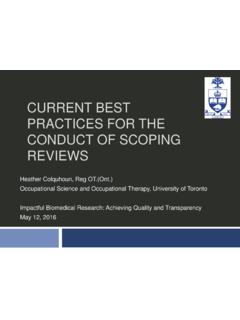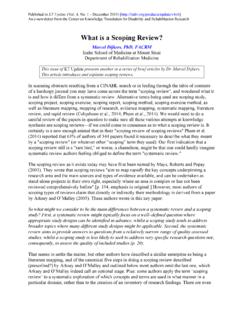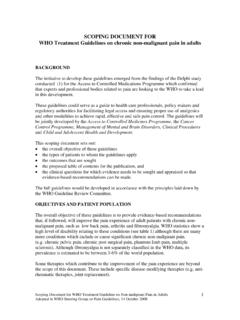Transcription of The connections between young people’s mental health and ...
1 The connections between young people 's mental health and sport participation: scoping the evidence Ann Hagell, Research Lead Association for young people 's health THE connections between young people 'S mental health AND SPORT PARTICIPATION: scoping THE EVIDENCE. Contents Executive summary 2 Executive summary Acknowledgements 2 In this scoping review we focused on the role of sport and organised physical activity in helping Background 3 to prevent and treat mental health problems in Setting out the questions 3 young people , particularly in the 14-25 age group. Methods 3 The results suggested: Key features of sport, organised There are positive associations between physical activity and mental health 4 sport and organised activity and mental Associations between sport and health outcomes for young people at all organised physical activity and mental levels of intervention. health outcomes for young people 5.
2 The relationship is strongest for the use of What is it about sport and organised sport to treat symptoms of clinical depression. activities that conveys the benefit? 6. Methodological shortfalls in the existing The importance of gender 8. research mean we have limited understanding The importance of equality of access about the exact positive benefits. These may and focus on vulnerable groups 8 be pharmacological, social or behavioural. Conclusions 9. Benefits may vary by gender and for References 10 young people from particularly vulnerable or excluded groups. There is no one size fits all' recommendation. There are many ways in which participation in sport and organised exercise can vary, and the effects may be different for different groups of young people . Acknowledgements This scoping review was supported financially by Sport England and has been undertaken as part of the wider Outcome Evidence Review that Sport England is currently leading on behalf of the whole sector.
3 We are very grateful to a number of colleagues who have provided extremely helpful feedback during the process of developing this review, particularly stakeholders who attended an AYPH/StreetGames event in May 2016, Alastair Loadman from the University of Winchester and Rebekah Carney from the University of Manchester. 2. THE connections between young people 'S mental health AND SPORT PARTICIPATION: scoping THE EVIDENCE. Background Setting out the questions Intuitively it seems obvious that sport and organised What components of sport seem to be linked to physical activities should promote good mental health . good outcomes, and what do we know about the Indeed, there is now a considerable literature suggesting potential mechanisms? a link between the two. Professional bodies such as the Royal College of Psychiatrists make it very clear in Specifically: their advice to the public that keeping active is critical for lowering depression, feeling good about yourself, What do we know about the relationship between concentrating, focusing and sleeping better, and a range sport and mental health outcomes for young people of other outcomes (Royal College of Psychiatrists, 2015; aged 14-25 in the UK?)
4 MIND 2015). Research has suggested that for depressed Are there differences between using sport to adults exercise is as good as drugs (Cooney et al, 2013). prevent mental health problems, to promote resilience and wellbeing, or to treat existing mental It is less clear what the messages are for young people , health problems? for example those aged 14-25. This is a life stage that brings huge physical, psychological and behavioural What are the key components of sport and organised In addition, there are a number of issues activities that have been linked to good outcomes and questions concerning the evidence. Even for older for young people ? And what do we know about the adults it is not clear whether different kinds of sport possible mechanisms? are useful for different mental health problems. The factors that mediate the relationship between organised What kind of interventions should be encouraged, physical activity and mental health symptoms are poorly and how can we support their implementation?
5 Understood. Given the very different life stages that they are at, there are likely to be differences between What kind of research do we need in the UK context the mechanisms and impacts of sport for adults versus if there are gaps in our knowledge? young people in this age range. It is also important to understand the impact of gender and socioeconomic issues on participation and outcomes. The most recent Cochrane review on the role of exercise in preventing and treating anxiety and depression in children and young people concluded that the research Methods data are sparse and mostly collected from college Although the evidence on the associations between students (Nordheim et al, 2010). However this was exercise and wellbeing is fairly well reviewed, less a fairly circumscribed exercise that relied on formal research directly addresses the relationship between research trials and addressed a specific question.
6 young people 's physical activity and mental health In addition it was not specifically focused on sport outcomes. We drew on existing reviews of the topic, and organised physical activity, nor especially on our searched electronic databases ( , MEDLINE, PubMed). age group. Elsewhere there is evidence that sport is and grey literature including policy reports, and a significant part of the package for positive youth consulted colleagues. We included all types of studies development for older teens (Holt 2008). In this scoping and took a broadly inclusive approach, with no time review we look at the full range of literature from limit. Search terms included variations on adolescence', preventing problems arising, promoting positive youth adolescent mental health ', young people 's mental development, and treating problems once they exist. health ', exercise', sport' and mental health outcomes'.
7 Separately we are complementing the results of this Preliminary findings from the review were discussed desk-based review by asking the views of young people , with a stakeholder group including representatives from key stakeholders and providers about what they think academia, policy and practice, resulting in additional works in the UK context. questions and new material for inclusion, and two focus groups with young people also fed into the direction of the review. 3. THE connections between young people 'S mental health AND SPORT PARTICIPATION: scoping THE EVIDENCE. Key features of sport, organised physical activity and mental health In this review our focus is on sport and organised There are many ways in which participation in sport physical activity. According to the Council of Europe's and organised exercise can vary, and these may be European Sports Charter (1993), sport is all forms of significant when considering the benefits.
8 For example, physical activity that aim at expression or improving participation can vary according to the range of activities physical fitness and mental wellbeing, forming social undertaken, the frequency or intensity of activities, and relationships or obtaining results in competition. the length of involvement over time (Zarrett et al, 2009). Within this broad definition, there are many different Some young people may not participate often, but may opinions as to what constitutes a sporting activity. For have been doing a little for a long time. Others may have the purposes of this review we have defined sport as patches of more intense participation but then patches including individual or group activities with an element of inactivity. These dimensions need to be considered of competition and skill. Organised physical activity is when we evaluate the outcomes of participation in sport.
9 A broader category that might involve exercise that is not competitive, such as social running clubs, but it still By mental health we mean a broad range of disorders implies activities that are structured, repetitive and that affect thinking, feeling or mood, and have an impact purposeful. This does not include exercise that happens on everyday functioning. Those most frequent problems as a by-product of everyday life, as doing chores or for young people include anxiety and depression, physical playing. The Chief Medical Officers' physical eating disorders, conduct disorder (serious antisocial activity guidelines for children and young people (2011) behaviour), substance use disorders, attention deficit and suggest that all children and young people should engage hyperactivity disorder (ADHD), and difficulties associated in moderate to vigorous physical activity for at least with the autistic spectrum disorders (Green et al, 2005).
10 60 minutes per day, with vigorous intensity activities, It has been estimated that three quarters of adult mental including those that strengthen muscle and bone, being health disorders will be present before the age of 18. incorporated at least three days a week. (Kim-Cohen et al, 2003), and so intervening in childhood and adolescence is critically important for preventing In searching the literature, we have concentrated continuing problems in adulthood. on young people of secondary school age and older. In the USA, sports are the most popular organised activity among youth (Sabo and Veliz 2008). Rates of participation in sport are also high in the UK. Amongst young people aged 11-15 years, 95% report that they have taken part in sports in the last four weeks, the majority of which occurs at school (Department for Culture, Media and Sport, 2015). The proportion taking part in sport outside school is much smaller; around one third.












